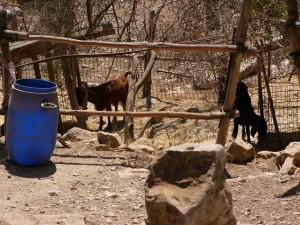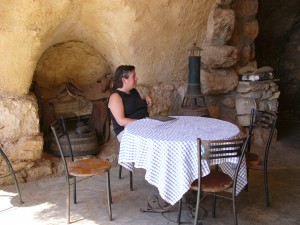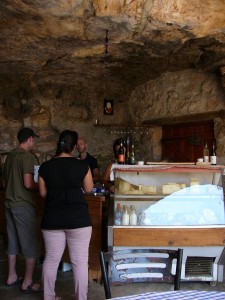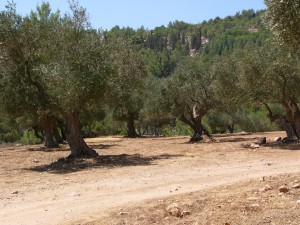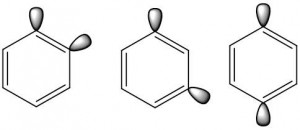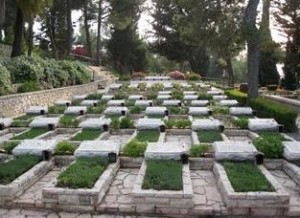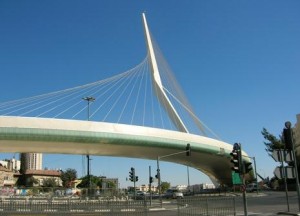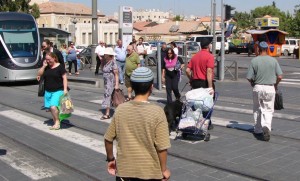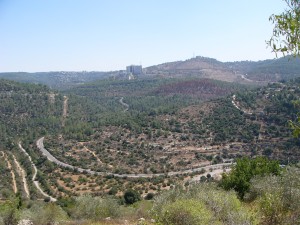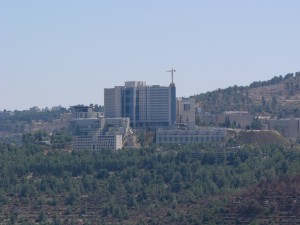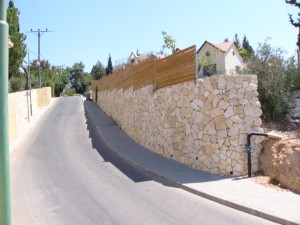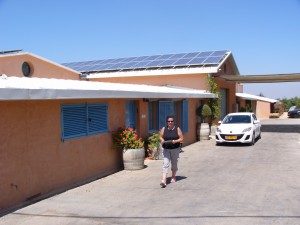Day Zero (Sunday; Yom Ree-Shon):
We’re on our way to Israel. It took us months of fretting and anxiety to prepare for this trip. We could fill a large notebook with the details that were required, ranging from buying tickets (not so easy since the State Department has restrictions), to spending two days in Washington for a Fulbright orientation, to arranging for living quarters in Jerusalem, to getting health insurance supplements, to preparing the house for our 4-month leave, to taking care of (preparing) four cars for our absence, to packing, to repacking to meet the luggage weight and size requirements, to repacking again, to getting all our electronics in shape and ready for use abroad, to arranging for online payment of all our bills for the next four months …. You get the idea. To say that we’re exhausted even before we leave is an understatement.
Well, we do hope to get a few Zs on the 10.5-hour flight from Newark to Tel Aviv. Since we both have Kindles (and we also bought an iPad), we’ll be well entertained. In addition, we can also browse the tour books and maps of Jerusalem. I doubt that we’ll be too bored between now and our arrival.
That’s the downside. On the other hand, we’ll be in Israel for four months – at the premier Hebrew University on a Fulbright Fellowship sponsored by the U.S. State Department and a Carole Weinstein Summer Grant from the University of Richmond. So, we’re exhausted yet very excited. It’s an interesting confluence of emotions, don’t you think?
We’ll let you know what happens when we arrive. What we do know is that we’re to be met at Ben Gurion Airport by a colleague from HU who will take us to our apartment, of which we know little (or nothing). College students all over again!
Day One (Monday; Yom She-Nee):
Well, we’re still on our way. We missed the connection to Tel Aviv because of a delay in Richmond. We stayed overnight at a hotel in Newark and got a fresh start on Mon. Morning. At least we’re in Newark on day one; 0.1% of the trip accomplished. Progress! We spent the day lounging around the hotel in the early morning and then around the airport waiting for our flight. The vouchers given us by United were enough to cover a pleasant lunch – without alcoholic beverages. Newark Airport, especially the International Terminal is nice – unlike JFK, which is a pit. We were able to schmooze a little and do some work on the computer (we have a MiFi that gives us access to the internet). The only drawback to the Newark AP is that they don’t believe in electrical outlets. We had to meander quite a bit to find ones that work. All that said, we’re ready to get on with the trip. The sun is shining and the rain has stopped (there was a downpour this morning). The flight is apparently on schedule and we’ll be on our way at 4 PM. More later.
Day Two (Tuesday; Yom Shelee-She):
We arrived in Israel pretty much on time, just a day late. We were met at the airport by Usha and a lovely bouquet of flowers! Usha is a post-doctoral fellow in the Shaik lab and she shepharded us through the (complicated!) process of taking the Airport/Tel Aviv to Jerusalem shuttle (in Hebrew shared taxi/bus is sherut) Thanks to Usha, the sherut deposited us directly at our apartment in the Beit Ha-Karem neighborhood of Jerusalem.
The apartment is very nice – airy and bright! İ It’s on the second floor (walk up) in a very quiet residential neighborhood. It is reasonably large with two bedrooms, four single beds (2 pushed together to form a double bed!), pretty good closet space, a good size kitchen with only the very basic appliances, a small water closet and small shower room and a good size living room with a sunroom. It’s better than we expected. There’s a supermarket about 10 minutes walk — uphill (it’s Jerusalem). With groceries, it’s downhill — whew! We’re exhausted from the trip and we’re trying to stay up until the usual bedtime. We’re now heading out for a stroll around the neighborhood and to look for a place for a quick dinner.
We ate at a local restaurant near another “strip mall,” and far from the tourist mecca. The food was good and plentiful. It’s clearly a local hangout for adults and teenagers, especially after sunset when the temperature drops.
Across the street from the store is the tram line which transsects Jerusalem. The cost for use is low and the train runs often. It’s a popular means of transportation here, since there’s little or no on street parking close the the Old City.
Well, our day really starts tomorrow when David (research associate of Sason, Carol’s host) picks us up at 9 AM for a tour of the University and some administrative stuff.
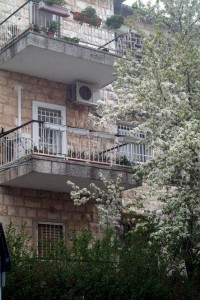 Beit HaKerem neighborhood where our apartment is located
Beit HaKerem neighborhood where our apartment is located
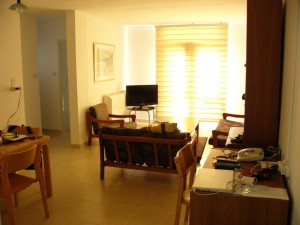 View of Apartment from Entryway (Bedroom+Bath to left; Kitchen and 2nd bedroom not shown)
View of Apartment from Entryway (Bedroom+Bath to left; Kitchen and 2nd bedroom not shown)
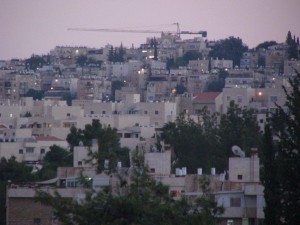 Evening view from bedroom window
Evening view from bedroom window
 Tram that runs from the suburbs to downtown
Tram that runs from the suburbs to downtown
Day Three (Wednesday; Yom Re-Ve-ee):
Today we registered at Hebrew University so we can get an ID card, etc. We visited the office where we’ll hang our hats for the time we’ll be here. We also started the process (and it’s a process) of getting a bank account, went to the post office to convert dollars to shekels and took the train and bus to the Malkah Mall on the other side of town. We finally got SIMM cards and a phone and bought some household items from a department store at the mall. Took a cab home and plopped on the couch to catch our breath. And it was only 3 PM. There’s no grass growing under our sneakers. We’re still suffering from jet lag. Maybe tomorrow we’ll do some Jerusalem stuff. We’ll go out for a quick dinner to the Falafel Bar near our apartment. That’ll be enough for the day.
 Hebrew University Givat Ram campus
Hebrew University Givat Ram campus
Day Four (Thursday; Yom Hah-Mee-Shee):
We navigated another day in the big J. It took several hours this morning to complete the bank account business and make a deposit. We’ll be getting our ATM cards in a day or two.
Then we walked several miles to find a place that sells used bikes — a 90 minute walk. The neighborhood (industrial/quasi-residential) is truly “native” with mostly orthodox Jewry — babies, babies and more babies. How the ultra-orthodox wear their dresses, black suits and hats in this weather is a mystery to me.
We finally found the bike store. It’s called “The Bike Way Jerusalem” and it’s located in the Givat Shaul neighborhood. The owner, Moshe, is from Minnesota and was extremely friendly and helpful. He suggested that we consider buying new bikes that he’ll buy back from us at 50%. He said it will save us money in the long run. We tried out several bikes and decided that the deal was worth it. It will wind up costing us $100 per month (for 2 bikes) for four months; and, we’ll have good, new bikes with no headaches. And he’ll provide free service. Yep, we took the bikes home — took us 10 minutes and it was a lot easier than the walk there. As long as we’re smart and careful, bikes will be a way to navigate J and other Israeli cities that we plan to visit.
This evening we decided to have dinner out, so we don’t have to cook. We are postponing that task as long as possible. We went to the famous Ben Yahuda Street by tram (easy ride). We walked to one of those small “fast food” stores for a falafel. If you like falafel, this is a great place to get it. It was terrific. It seems that Ben Yahuda Street in August is an extension of NYC or Long Island – mostly Americans between the ages of 15 and 20 – and loud. For dessert, we had gelato/sherbet. Then we headed back to the tram via side streets just to explore. We got home safe and sound and pooped. Hit the hay before ten. So far, so good!
Day Five (Friday; Yom Shee-Shee):
So far, each day has been quite different. Our main goal for today is grocery shopping, since the supermarkets in J are closed on Saturday. We decided to have a sabbath dinner at home – our first here.
We’re masochists, so we went to the Yahuda Market by tram (the new surface train) — on a Friday afternoon? Again, we’re crazy since this is THE MARKET in Jerusalem. Yes, we’re nuts. What fun!!!! But we learned how to buy and how to bargain amidst the masses. Fortunately we took two backpacks and plenty of shekels. We came home loaded with everything from garlic to halvah, from chicken to nuts and fruit, and a knife and cutting board. We even bought a plastic milk carton to connect to the bike — next time we go by bike. We came home exhausted as usual.
However, after a brief rest, we’re off to another store to buy bottled water. Although several people have said that the water in this area (Beit Ha-Karem) is OK to drink, those that told us that drink bottled water. Hey, we’re no dummies! Unfortunately, all the stores were closed. We did find a small corner shop that sold us two bottles just before he closed. We went home and cooked our first dinner in the apartment – roast chicken with garlic and olives and roasted small white potatoes. It was delicious. And the wine (Israeli) was great.
Carol plans to work tomorrow (Sat.) while everybody else is off. We’ve set up office space in the apartment; we have high speed internet and we can VPN to the U of R computer center to maintain security.
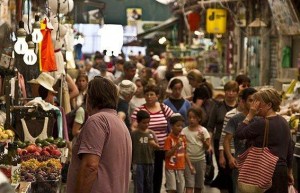 Yehuda Market
Yehuda Market
Day Six (Saturday; Yom Sha-bat):
This was very unusual day. We didn’t do much of anything all day. We got up late (very late) and lounged around the apartment all day – – reading writing and feeling homesick. Well it is Shabbat and most everything is closed – stores, restaurants, transportation etc. There was no obvious reason for our funk. The Fulbright people warned us about fits of depression, especially in the early phases of the trip. Once we recognized that this might be the case, we forced ourselves to dress and we went for an evening bike ride, first to the University (we toured the entire campus), then around our vicinity. We wound up finding a huge dog park (made us miss Nordic), then found the Knesset (Israeli Parliament building), and rode through Knesset Park after dark (we have flashers on the bikes). After two hours of riding, we went to a local restaurant, had sandwiches, rode back to the apartment and felt relieved that we accomplished ‘something’ today.
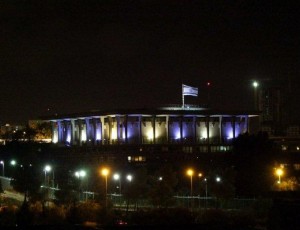 Knesset at night
Knesset at night
Day Seven (Sunday; Yom Ree-Shon):
We got up early today (7:30AM) to get discounted train/bus passes at the Central Bus Station downtown. We tried this earlier in the week during the day but the crowds were enormous, especially the touring groups of rowdy U.S. teenagers. Today, no one was there and we breezed in and out. Now we have an official picture ID and we can buy packages of discounted bus/train tickets at any station.
It was 8:30AM and we headed to the Old City. By 9 we were walking thought the Damascus Gate, which leads into the Arab Quarter. Most shops were not yet open, so we meandered from the Arab Quarter to the Christian Quarter etc. We stopped at a “cave” restaurant for a cup of terrible coffee. Then off to the bazaars. We roamed this way and that, spent some time in the Church of the Holy Sepulcher, stopped for breakfast at Menorah’s Cafe (ate shakshuka, which is a delicious baked dish made of seasoned crushed tomatoes with spices and eggs in the middle).
 Mmmm. Shakshuka – a breakfast dish of baked spicy tomatoes, cheese, garlic and poached eggs!
Mmmm. Shakshuka – a breakfast dish of baked spicy tomatoes, cheese, garlic and poached eggs!
Afterwards, we walked around, visited the Contemporary Art Foundation, went to the Armenian Quarter, stopped by a ceramics place where the ceramics are made on site, got lost, got found again, stopped at Jaffar’s, which is famous for their kanaffeh (a very tasty treat made of who knows what including mild cheese, sesame seeds and honey) and then headed home (it’s 5 PM and we’re pooped). We also stopped at a food market to pick up dinner stuff and liquid refreshments (OK, we mean beer and wine). There is something good about expending more energy obtaining your food and drink than you gain from ingesting it but it is exhausting not having a car.
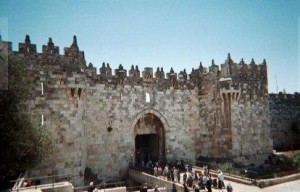 Damascus Gate – Old City
Damascus Gate – Old City


